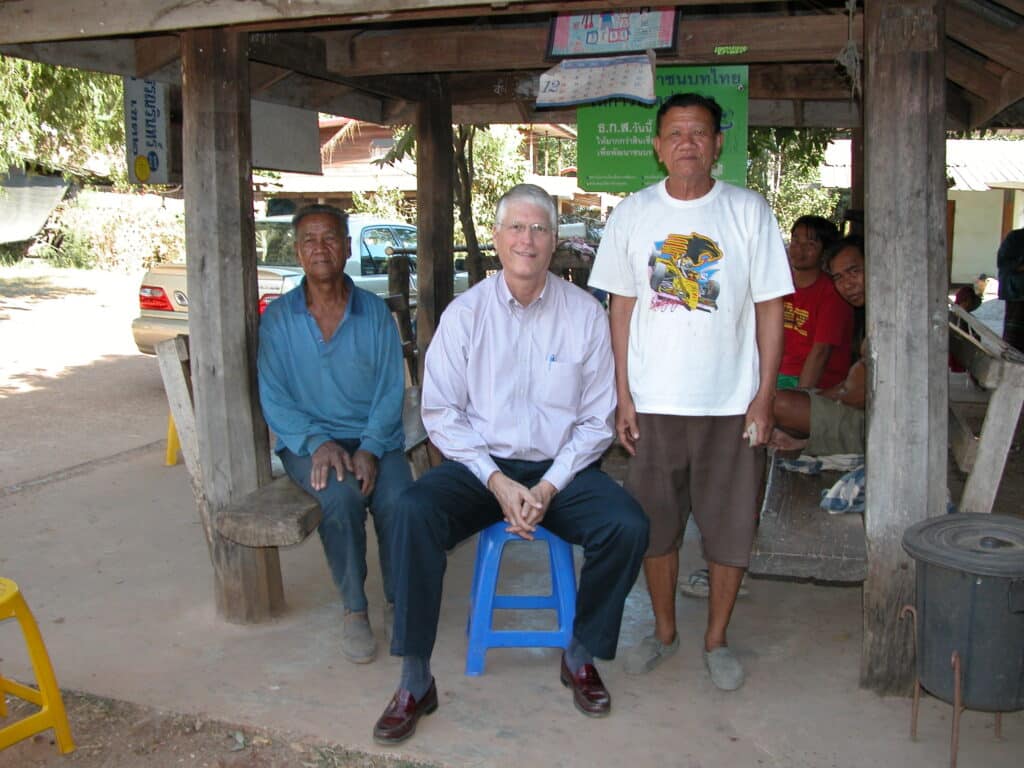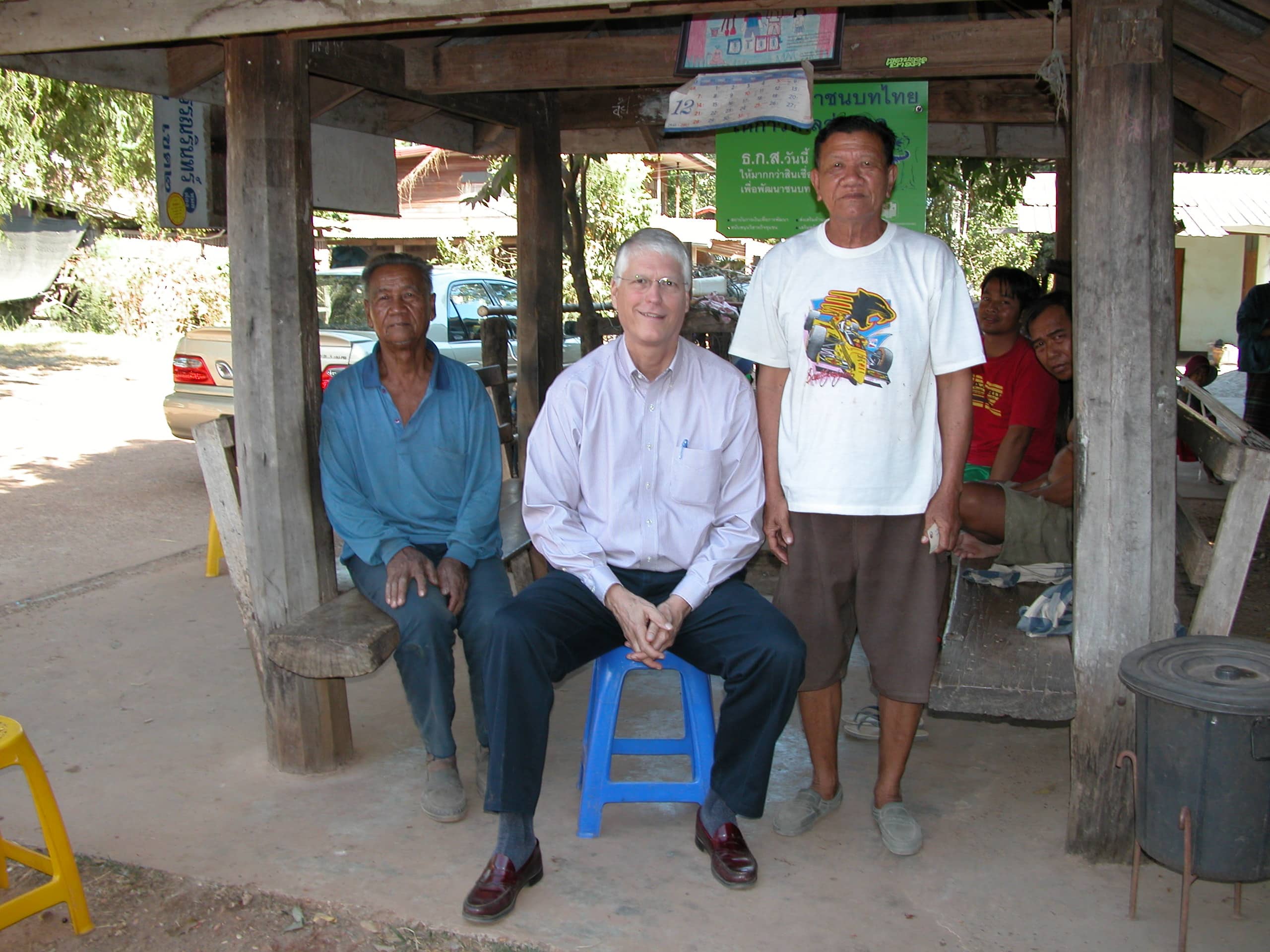My story begins in 1966 and is an account of what I believed for 37 years to be a failed project. I had many opportunities to revisit the project site, but for reasons that even now I cannot fully explain, I avoided doing so. It wasn’t until December of 2003 that I returned to the place where the story began – a place where I was finally able to put to rest an unsettled spirit that haunted me for years.
I arrived in Nong Khai, Thailand in January 1966, 22 years old and fresh out of college. I was assigned a wonderful Thai community development co-worker, Wichian. Within a few months we were working on agricultural projects with a group of villagers in Ban Bong, which was located about an hour’s bicycle ride along a dirt road east of town.
The village headman of Ban Bong indicated his villagers were interested in developing a fishpond and showed us a small swampy area, which the villagers said never went dry. There were some fish there, but they weren’t very good to eat. They wondered if the swamp could be developed into a larger pond stocked with a better variety of fish. Wichian and I were eager to help.

However, the villagers said the spirits that occupied the swampy area would have to be appeased. The local monks prescribed a ceremony including various offerings to the spirits. These were performed, the natural poison was applied to get rid of the predator fish, and the dam was constructed.Wichian and I pitched in to help with the construction of the dam. It was a great Peace Corps moment. I thought to myself, Finally here is something tangible that will be here long after I’m gone.
I knew very little about raising fish, but my Peace Corps training had prepared me to utilize local resources. I facilitated a connection between extension workers at the government fisheries station in the neighboring province and the Ban Bong villagers. The villagers were advised that if they got rid of the predator fish by using a natural poison and constructed a small earth dam, they would capture more water during the rainy season, thus giving them a sizable fishpond. The extension workers agreed that if this was done, they would stock the pond with 15,000 fingerlings of a newly introduced variety of fast growing and producing fish. It sounded great!
But in mid-August 1966, the new pond was flooded before the fisheries department was able to stock the pond. In fact, it rained so much that a 100-year flood occurred all along the Mekong River that flows not far away. When the floodwaters receded, it was discovered that the dam was destroyed. The pond had looked so nice before the flood that I thought it would be a good idea to rebuild the dam and try again. However, the villagers said they were concerned that we had failed to fully satisfy the spirits of the land on our first attempt. We would have to try again to appease them before we could do any more work.

Once again, we consulted with the monks who prescribed additional rituals and offerings to the spirits of the land. These were performed and the rebuilding of the dam was completed. The rains came, and once again the pond was brimming with water. It was a day of celebration for the whole village when the extension workers from the fisheries department showed up to release the 15,000 fingerlings. It was my second year as a PCV, and I would be leaving in a few short months.
I was one happy volunteer. Then word came from Ban Bong less than a month later that the fishpond had mysteriously gone bone dry. I rushed out to the village and there it was – a dry depression in the ground that nearly sent me into depression. Two years of effort on the fishpond and there was nothing to show for it but a dry hole in the ground.
Shortly thereafter, I completed my service. And even though I spent the next 12 years working in Thailand and neighboring countries, I never went back to Ban Bong. Even after settling back in the United States in 1979, there was never a year that I didn’t visit Thailand at least once; but still, I couldn’t bring myself to visit.
In 2002, I returned to Thailand as the Peace Corps Country Director. As I was making site visits, we happened to drive past the village of Ban Bong. I decided to find out what had happened with the fishpond. An elderly white-haired man greeted me with, “Wilaat, we haven’t seen you for years! How have you been? Why haven’t you come to visit?” I was amazed and pleased that he remembered me by the Thai name I had been given.

Not long after, the former village headman came rushing over, “Wilaat, welcome back! It’s so good to see you after such a long time.” We sat in the shade talking until I finally got around to asking the question that had been on my mind for so many years.
“Do you remember the fishpond we tried to put in? Did it ever work out?”
The old headman let out a big laugh saying how crazy we all were to try to put a fishpond in that spot. By constructing the dam, we had likely blocked the natural drainage and that as soon as the rains stopped, there was no means to supply water to the pond. They had eventually filled in that swampy area and put the land to other use. I was starting to feel disappointment all over again.
But before my spirits could sink very far, he asked, “Wilaat, do you remember the watermelon demonstration plot you helped us put in right over there?” He explained that as a result of that demonstration plot, watermelons became a major cash crop for his village.
Then he asked, “Do you remember the little irrigation canal that you helped us construct?” We had joined with the villagers in digging what seemed like an insignificant little ditch. He explained with great enthusiasm that not only was that little canal still in use today, but that it was the beginning of an extensive irrigation system that over the years helped stabilize their annual rice production.
Would watermelons have become a major cash crop, or would the irrigation system have been developed even if a Peace Corps Volunteer hadn’t spent time in Ban Bong in 1966-67? Perhaps.
But clearly, our service made a far greater impact and impression than I ever imagined. It was a relief to know that, rather than the failed fishpond, the people of Ban Bong not only remembered but attributed some of their successful development to this now aging former PCV who helped them plant a few watermelon seeds and dig a small ditch nearly four decades earlier. While this was my experience, it is really our story – the story of thousands of PCVs who planted seeds, dug ditches, or worked with teachers. Then we moved on and for the most part never fully realized our positive impact. If you are a current or former PCV, I hope my story puts to rest any doubts you might have about the value of your service.





